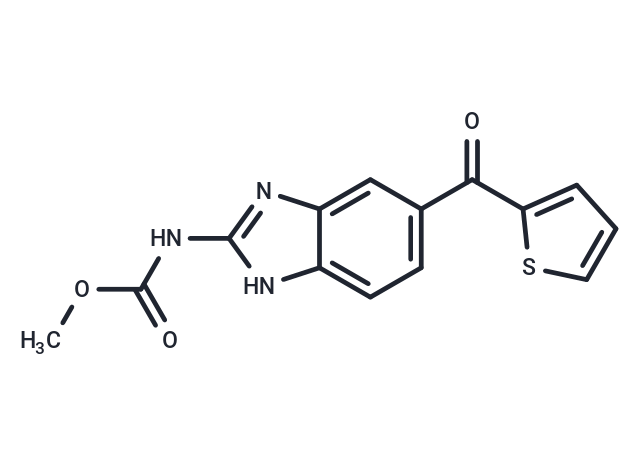Shopping Cart
- Remove All
 Your shopping cart is currently empty
Your shopping cart is currently empty

Nocodazole (Oncodazole) is a reversible inhibitor of microtubule polymerization and an inhibitor of Bcr-Abl. Nocodazole has antitumor activity, blocks the cell cycle and induces apoptosis.

| Pack Size | Price | Availability | Quantity |
|---|---|---|---|
| 5 mg | $31 | In Stock | |
| 10 mg | $50 | In Stock | |
| 25 mg | $100 | In Stock | |
| 50 mg | $177 | In Stock | |
| 100 mg | $297 | In Stock | |
| 200 mg | $443 | In Stock | |
| 500 mg | $718 | In Stock | |
| 1 mL x 10 mM (in DMSO) | $34 | In Stock |
| Description | Nocodazole (Oncodazole) is a reversible inhibitor of microtubule polymerization and an inhibitor of Bcr-Abl. Nocodazole has antitumor activity, blocks the cell cycle and induces apoptosis. |
| Targets&IC50 | Abl (T315I):0.64 μM, Abl:0.21 μM, Abl (E255K):0.53 μM |
| In vitro | METHODS: Erythrocytes were treated with Nocodazole (15-60 µg/mL) for 48 h. Phosphatidylserine was detected using Annexin-V-FITC. RESULTS: Nocodazole treatment increased the percentage of phosphatidylserine exposed to erythrocytes, reaching statistical significance at 30 µg/mL. [1] METHODS: hESCs cells were treated with Nocodazole (100 ng/mL) for 16 h and cell cycle profiles were analyzed using Flow Cytometry. RESULTS: Nocodazole treatment synchronized the cell cycle (>90% of cells in G2/M), while cells remained synchronized after release and moved evenly through the cell cycle for 24 h. At 2 h after removal of Nocodazole, the cells entered the G1 phase, with 70% of the cells in the G1 phase after 4 h, and 80% in the S phase after 12 h. The cells were treated with Nocodazole (100 ng/mL) for 16 h, and the cell cycle was analyzed by Flow Cytometry. [2] |
| In vivo | METHODS: To detect anti-tumor activity in vivo, Nocodazole (12 mg/kg three times a week) and dexamethasone (2 mg/kg twice a week) were injected intraperitoneally for fifteen days into immunodeficient mice bearing myeloma H929. RESULTS: Nocodazole in combination with dexamethasone significantly inhibited myeloma tumor growth and prolonged survival. [3] METHODS: To study the effects on intestinal mucositis, Nocodazole (5 mg/kg) and ketoconazole (50 mg/kg) were administered intraperitoneally three times a week for six weeks to nude mice harboring the human colorectal cancer tumor COLO 205. RESULTS: The antitumor effect of Nocodazole was significantly enhanced after six weeks of ketoconazole treatment. [4] |
| Cell Research | Nocodazole is dissolved in a final concentration of 0.05% DMSO. Proteins are loaded at 50 μg/lane and separated by 12% (w:v) sodium dodecyl sulfate-polyacrylamide gel electrophoresis, blotted, and probed with antibodies for cyclin E, p53, p21/CIP1, p27/KIP1, glyceraldehyde 3-phosphate dehydrogenase (GAPDH), cyclin A, cyclin D1, cyclin D3, cyclin B, CDK2, CDK4, and cytochrome C. Immunoreactive bands are visualized by incubating with the colorigenic substrates nitroblue tetrazolium and 5-bromo-4-chloro-3-indolyl-phosphate. The expression of GAPDH is used as the control for equal protein loading. |
| Alias | R17934, Oncodazole |
| Molecular Weight | 301.32 |
| Formula | C14H11N3O3S |
| Cas No. | 31430-18-9 |
| Smiles | COC(=O)Nc1nc2cc(ccc2[nH]1)C(=O)c1cccs1 |
| Relative Density. | 1.49 g/cm3 |
| Storage | Powder: -20°C for 3 years | In solvent: -80°C for 1 year | Shipping with blue ice. | |||||||||||||||||||||||||
| Solubility Information | DMSO: 12.5 mg/mL (41.48 mM), Sonication is recommended. | |||||||||||||||||||||||||
Solution Preparation Table | ||||||||||||||||||||||||||
DMSO
| ||||||||||||||||||||||||||

Copyright © 2015-2025 TargetMol Chemicals Inc. All Rights Reserved.